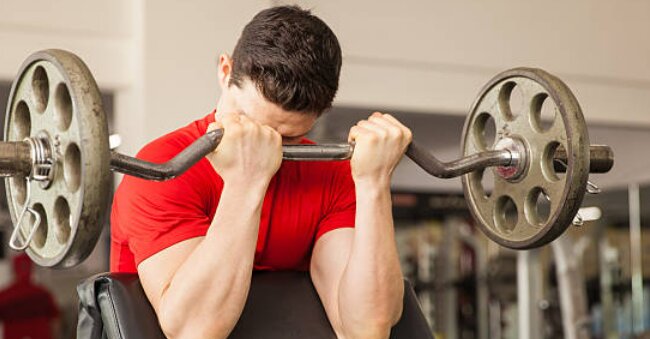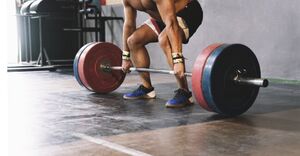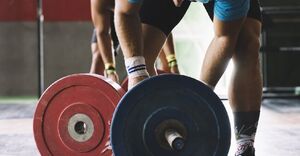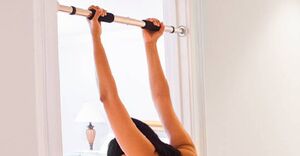
Top 5 Curl Barbell Exercises to Maximize Your Bicep Gains
If you’re looking to take your arm and shoulder workouts to the next level, incorporating a curl barbell into your routine might be just what you need.
But what exactly is a curl barbell and why should you use one? In this article, we’ll explore the benefits of using a curl barbell, the muscles it targets, how to use it properly, and the top 5 exercises you should master.
Get ready to elevate your workout game and see real results!
What is a Curl Barbell?
A Curl Barbell, also known as an EZ curl bar, is a type of weightlifting equipment commonly used in gyms and home setups for various exercises targeting different muscle groups.
Designed with a unique curved shape that allows for a more natural grip and wrist positioning, the Curl Barbell is an essential tool for performing bicep curls, tricep extensions, and shoulder exercises.
Its versatility extends beyond arm workouts, as it can also be used for squats, lunges, and rows, providing a well-rounded approach to strength training.
The bar’s design helps alleviate strain on the wrists and elbows, making it a popular choice for individuals looking to reduce discomfort during lifting sessions.
Incorporating a Curl Barbell into your routine can help increase muscle engagement and improve overall stability during workouts.
Why Use a Curl Barbell?
Incorporating a Curl Barbell into your strength training regimen can be highly beneficial for targeting specific muscle groups such as the biceps, triceps, and forearms, helping you achieve your fitness goals effectively.
By utilizing a Curl Barbell, you can engage these muscle groups more effectively, as the unique design of the bar allows for a natural hand position, reducing strain on the wrists and elbows. This not only helps in building muscle mass but also enhances overall workout efficiency. The Curl Barbell enables a variety of grip options, providing versatility in exercises to prevent plateaus and continually challenge your muscles, leading to better results in your fitness journey.
What Muscles Does a Curl Barbell Work?
When using a Curl Barbell, you engage various muscle groups, including the biceps, triceps, and forearms, making it a versatile tool for upper body workouts in the gym.
The biceps, located at the front of the upper arm, are primarily responsible for elbow flexion when performing curls with the Curl Barbell. Engaging the triceps, on the other hand, which are located at the back of the upper arm, helps stabilize the elbow joint and provide support during the movement. The forearms play a crucial role in grip strength and endurance, which are vital for maintaining control of the barbell throughout each repetition.
By working all these muscle groups together, the Curl Barbell not only targets specific areas but also promotes overall upper body strength and coordination.
Biceps
The Biceps are prominently worked when performing exercises with a Curl Barbell, helping in muscle building and toning for a well-rounded upper body strength training routine.
Targeting the biceps with a Curl Barbell is crucial for achieving defined and strong arm muscles. Incorporating various exercise routines such as standing curls, preacher curls, and hammer curls can provide comprehensive stimulation to different parts of the biceps for balanced development. It’s recommended to vary repetition ranges, including lower reps with heavier weights for strength gains and higher reps with lighter weights for muscle endurance. By focusing on the biceps with a Curl Barbell, individuals can improve their overall muscle definition, enhance arm strength, and create a visually appealing physique.
Forearms
Using a Curl Barbell effectively engages the forearms, enhancing grip strength, and promoting muscle endurance, crucial for maintaining proper form and technique during upper body workouts.
The forearms play a vital role in various exercises, serving as a link between your hands and the weights. By incorporating a Curl Barbell into your workout routine, you target the muscles in the forearms more specifically, aiding in their development and improving overall strength.
The repetitive motion of curling the barbell up and down can significantly enhance your grip strength, which is essential for handling heavier weights and preventing injuries. This exercise not only builds physical strength but also cultivates mental toughness and focus, essential for pushing through challenging sets and achieving your fitness goals.
Shoulders
Incorporating shoulder exercises with a Curl Barbell into your training program can effectively activate the shoulder muscles, improve range of motion, and contribute to a well-rounded upper body workout routine.
Utilizing a Curl Barbell for shoulder workouts can target specific muscle groups like the deltoids, helping to build strength and definition in your shoulders. The unique design of the Curl Barbell allows for a more natural grip, reducing strain on the wrists and elbows during exercises like overhead presses and lateral raises.
By engaging the shoulders in various movements with the Curl Barbell, you can enhance stability and coordination, essential for overall upper body strength development. Adding these exercises to your routine can lead to improved posture, increased shoulder stability, and enhanced muscular endurance.
Back
Integrating exercises targeting the back muscles with a Curl Barbell can enhance both strength and endurance, making it a valuable tool for resistance training to develop a strong and functional back.
By engaging in back exercises with a Curl Barbell, you are not only strengthening the major muscle groups like the latissimus dorsi and trapezius but also working on stabilizer muscles to improve overall back stability. The controlled movements with the Curl Barbell allow for a full range of motion, helping to prevent injuries and promote proper muscle activation. Consistent resistance training through variations of back exercises can lead to better posture, decreased risk of back pain, and improved performance in daily activities and sports.
How to Properly Use a Curl Barbell?
To maximize the benefits of using a Curl Barbell, it is essential to focus on proper execution, maintain correct form throughout the exercises, adjust resistance levels effectively, and incorporate variations to prevent plateaus in your workout routine.
Proper form is crucial when performing bicep curls with a Curl Barbell. Ensure your back is straight, shoulders are relaxed, and elbows are close to your body.
When adjusting resistance levels, start with a weight that challenges but allows you to complete the desired number of repetitions with good form. Experiment with different grips and hand placements to target various muscles and keep your workouts exciting.
Adding in exercise variations like incline curls or reverse curls can help engage different parts of the bicep and prevent your muscles from becoming accustomed to the same movements.
Warm Up
Prior to using a Curl Barbell, it is crucial to include a proper warm-up routine to prepare your muscles, reduce the risk of injuries, aid in muscle recovery, and optimize training frequency for consistent progress.
Engaging in dynamic stretches and light cardiovascular activities like jogging or jumping jacks can increase blood flow and enhance flexibility in the muscles surrounding the joints, thus improving your range of motion during Curl Barbell exercises.
By incorporating activation exercises such as arm circles and wrist rotations, you can stimulate the targeted muscle groups and mentally focus on the upcoming workout, setting the foundation for proper form and technique.
These warm-up activities play a vital role in preventing strains, sprains, and other workout-related injuries by priming your body for the upcoming challenges.
Choose the Right Weight
Selecting the appropriate weight when using a Curl Barbell is essential for progression in weightlifting, ensuring gradual strength gains, muscle tone development, and overall improvement in your fitness journey.
When determining the right weight for your Curl Barbell exercises, it’s important to consider your current fitness level and goals. Starting with a weight that challenges you but still allows for proper form is key. As you progress, gradually increase the weight to continue pushing your muscles and stimulating growth. Remember that using too heavy a weight can lead to improper technique and potential injury, so always prioritize safety.
By finding the ideal balance between challenge and control, you’ll optimize your workouts for maximum strength gains and muscle tone enhancement.
Maintain Proper Form
Maintaining proper form while using a Curl Barbell is crucial for optimizing athletic performance, ensuring effective muscle activation, and facilitating continuous fitness progress towards your goals.
When you maintain the correct form during Curl Barbell exercises, you not only prevent potential injuries but also engage the targeted muscles more efficiently. This leads to increased muscle activation, promoting strength gains and muscle growth. The emphasis on form ensures that you are working the intended muscle groups properly, allowing for better results and progression in your fitness journey. By honing in on the right technique, you set yourself up for improved performance in various sports and activities, enhancing overall athletic capabilities.
Breathe Correctly
Proper breathing techniques while using a Curl Barbell help improve endurance, promote muscle definition, and contribute to achieving fitness success by optimizing oxygen intake during workouts.
By focusing on controlled inhalation and exhalation patterns, individuals can effectively manage their energy output and prevent fatigue during challenging exercises. Consistent deep breathing not only facilitates the delivery of oxygen to the muscles but also aids in removing waste products, allowing for improved performance and faster recovery. Proper breathing rhythm ensures alignment of movements, reducing the risk of injury and enhancing the overall effectiveness of the workout. Understanding the significance of breathing in conjunction with Curl Barbell exercises can lead to better results and a more fulfilling fitness journey.
Top 5 Exercises to Master with a Curl Barbell
Mastering specific exercises with a Curl Barbell can enhance muscle activation, promote compound movements, and provide an effective workout routine targeting various muscle groups for overall strength and endurance.
- One of the top exercises to master with a Curl Barbell is the Barbell Curl. This exercise primarily targets the biceps, forearms, and shoulders, helping to improve arm strength and definition. By curling the barbell towards the chest while keeping the elbows stable, you engage the muscles in a controlled manner, enhancing muscle activation.
- Another essential exercise is the Skull Crusher, which targets the triceps. This movement involves lowering the barbell towards the forehead, working the triceps efficiently.
- The third vital exercise is the Bent-Over Row, which engages the back, biceps, and shoulders. This compound movement helps improve posture and overall back strength.
- Moving on, the Standing Military Press is an effective way to target the shoulders and triceps. By pressing the barbell overhead, you engage multiple muscle groups simultaneously, promoting muscle activation and strength development.
- Mastering the Deadlift with a Curl Barbell is crucial for overall strength and lower body engagement. This compound movement targets the hamstrings, glutes, lower back, and core, enhancing functional strength and muscle coordination.
Incorporating these exercises into your routine can elevate your workout and lead to significant gains in muscle activation and overall fitness.
Bicep Curl
The Bicep Curl with a Curl Barbell is a fundamental exercise for targeting the biceps, focusing on repetitions and sets to build strength and achieve continuous gains in bicep muscle development.
By properly executing this exercise, individuals can maximize their bicep gains by following recommended repetition ranges of 8-12 reps per set, ensuring the muscle is adequately fatigued for optimal growth. Variation in sets, such as 3-4 sets per session, can further challenge and stimulate the biceps, leading to increased strength gains over time. Consistency in performing this exercise with proper form and technique is key to seeing improvement and sculpting well-defined biceps.
Hammer Curl
The Hammer Curl using a Curl Barbell targets the biceps and forearms, enhancing range of motion, aiding in muscle recovery, and serving as a source of fitness inspiration for varied workout routines.
By engaging in Hammer Curl exercises with a Curl Barbell, individuals can experience significant improvements in their range of motion, allowing for better flexibility and joint health. The controlled movements of this exercise promote muscle recovery by increasing blood flow to the targeted areas, aiding in the repair and growth of muscle fibers.
Incorporating Hammer Curls into your fitness routine can also serve as a motivating factor, pushing you to challenge yourself and achieve new levels of muscle activation and workout inspiration.
Reverse Curl
The Reverse Curl exercise with a Curl Barbell targets the forearms and biceps, providing resistance training to support fitness goals achievement and showcase dedication towards strengthening specific muscle groups.
This particular exercise is a staple in many strength training routines due to its ability to isolate and effectively work the forearms and biceps. By engaging in consistent practice with the Curl Barbell while maintaining proper form, individuals can witness significant improvements in grip strength and arm endurance over time.
The key to maximizing the benefits of the Reverse Curl technique lies in maintaining a steady pace and gradually increasing the resistance to challenge the muscles and promote growth. With dedication and commitment to regular training sessions, individuals can achieve remarkable gains in forearm and bicep strength, ultimately enhancing their overall fitness journey.
Shoulder Press
Performing the Shoulder Press with a Curl Barbell engages the shoulder muscles, requiring proper execution for continuous fitness progress and showcasing commitment towards achieving upper body strength and endurance.
This compound exercise not only targets the deltoids but also activates the trapezius and triceps, contributing to a well-rounded upper body workout routine.
By incorporating the Shoulder Press with a Curl Barbell into your fitness regimen, you elevate the challenge level and promote muscle growth.
Consistent practice of this exercise fosters muscle endurance, aids in maintaining proper form, and enhances overall shoulder strength.
To maximize the benefits and avoid injury, it is crucial to maintain a controlled motion and focus on gradual weight increments to track your progression effectively.
Bent Over Row
The Bent Over Row exercise using a Curl Barbell is beneficial for enhancing muscle tone, promoting a fitness lifestyle, and cultivating a positive fitness mindset focused on achieving optimal results in back muscle strength and definition.
This compound exercise primarily targets the muscles in the back, including the latissimus dorsi, rhomboids, and traps, while also engaging the biceps and forearms. By incorporating the Curl Barbell, individuals can intensify the workout and stimulate muscle growth effectively.
Consistent practice of Bent Over Rows with a Curl Barbell not only strengthens the upper body but also contributes to improved posture and overall body stability. This exercise promotes functional strength that translates into everyday activities, encouraging individuals to make healthier lifestyle choices to support their fitness goals.
How to Incorporate a Curl Barbell into Your Workout Routine?
Integrating a Curl Barbell into your workout routine can be dynamic by incorporating it for isolation exercises, compound movements, and challenging supersets, providing inspiration for varied workouts and overcoming fitness challenges.
The versatility of a Curl Barbell allows you to target specific muscle groups with exercises like bicep curls, while also engaging multiple muscle groups in movements like bent-over rows. By incorporating different grips and hand positions, you can add variety and intensity to your workouts, keeping your muscles guessing and continuously adapting. Setting up workout challenges with the Curl Barbell, such as increasing repetitions or incorporating timed sets, can push you to new limits and ignite your drive to achieve greater fitness goals.
Use it for Isolation Exercises
Incorporating a Curl Barbell for isolation exercises allows targeted muscle group activation, facilitating progress in fitness goals by emphasizing specific muscle groups during workouts.
This specialized type of barbell plays a crucial role in honing in on particular muscles, such as the biceps and forearms, leading to enhanced muscle engagement and development. By isolating these muscles, the Curl Barbell helps to improve strength and definition in these areas.
Focusing on specific muscle groups aids in preventing imbalances and ensures a more symmetrical physique. This deliberate muscle targeting can significantly contribute to overall fitness progress, helping individuals achieve their desired muscle tone and strength levels.
Use it for Compound Exercises
Utilizing a Curl Barbell for compound exercises allows for progressive overload, leading to improved fitness results and showcasing dedication towards achieving comprehensive muscle engagement and workout efficiency.
By incorporating a Curl Barbell into your workout routine, you are setting the stage for steady growth and enhanced performance. The use of this specialized equipment not only aids in targeting multiple muscle groups simultaneously but also enables you to intensify your training sessions effectively. The commitment to consistently challenge your body through progressive overload techniques is key in sculpting a stronger and more defined physique. With a focus on proper form and controlled movements, individuals can experience significant improvements in strength, endurance, and overall fitness levels.
Use it for Supersets
Incorporating a Curl Barbell for supersets can lead to fitness success by promoting muscle endurance, commitment to challenging workouts, and discipline in maintaining workout intensity for optimal fitness results.
By engaging in supersets with a Curl Barbell, individuals can push their limits and enhance their muscle endurance over time. This method not only cultivates physical strength but also strengthens one’s mental fortitude, fostering a deeper commitment towards consistently challenging oneself in workouts.
The discipline required to sustain high-intensity sessions with a Curl Barbell builds the foundation for long-term progress and overall fitness improvement, instilling a sense of accountability and perseverance in every gym session.
Tips for Using a Curl Barbell Safely and Effectively
To ensure safe and effective use of a Curl Barbell in your workout routine, it is essential to focus on injury prevention, maintain a proper range of motion, adopt a fitness-oriented lifestyle, and strive for continual achievements in your fitness journey.
One important aspect of injury prevention when using a Curl Barbell is to start with lighter weights and gradually increase the load as your strength and technique improve. It’s also crucial to pay attention to your form during each repetition, avoiding jerky movements that can strain your muscles.
Incorporating mobility exercises into your warm-up can help increase flexibility and reduce the risk of injury. Building a fitness-focused lifestyle involves not only regular exercise but also proper nutrition, sufficient rest, and staying hydrated. To achieve consistent fitness accomplishments, maintaining a positive mindset and setting realistic goals are key components for long-term success.
External Resource: https://nutroone.com/en/product/fixed-weight-curl-straight-barbell-set/




No Comments